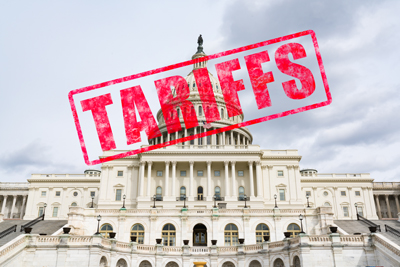SEMA News—August 2019
LEGISLATIVE AND TECHNICAL AFFAIRS
Are Tariffs Bargaining Chips or Permanent?
SEMA Welcomes Trade Negotiations, Opposes Tariffs
 Legislation is being considered that would require congressional approval of tariffs imposed or, alternatively, provide Congress the option to overturn any imposed tariffs. |
The global trading system has the potential to foster economic growth and support peaceful relations between nations. If it breaks down, it can lead to confrontation as countries seek to shield their domestic industries. Tariffs can be a powerful tool for leveling the playing field or, conversely, lead to trade wars and protectionism. The Trump Administration is using tariffs to strengthen its hand in trade negotiations with its trading partners. Is the strategy working?
First, a little background.
Following World War II, the United States led the effort to encourage international trade within a rules-based, open trading system. The 1948 General Agreement on Tariffs and Trade led to the present-day World Trade Organization, which produced widespread prosperity, lower prices, greater consumer choice and an easing of international tensions.
Nevertheless, globalization created significant problems. For example, it has been difficult for U.S.-based manufacturers to compete against lower wages found in other countries. China, in particular, has posed significant problems for U.S. manufacturers. China joined the World Trade Organization in 2001, and the hope was that it would open its markets and create opportunities for U.S. manufacturers as part of the world trading community. That hope, however, has been undermined by China’s use of currency manipulation, intellectual-property theft, and other unfair trade practices. Which brings us back to the current U.S. trade negotiations.
The Trump Administration began with a bold agenda: demand fair trade and renegotiate trade pacts. SEMA applauded the goal, especially with respect to securing structural reforms in the U.S./China trade relationship and protecting intellectual property rights.
Beyond unfair trade, the Trump Administration has pursued perceived threats to U.S. national security. The first concern was U.S. domestic production of steel and aluminum. By early 2018, U.S. steel mills were operating at 73% of capacity, and more than half of U.S. aluminum capacity lay dormant, with imports accounting for 90% of U.S. aluminum consumption. Since the tariffs were imposed in June 2018, U.S. domestic steel production is now above the 80% capacity goal, but aluminum production still lags.
Imposing 25% tariffs on steel and 10% on aluminum helped domestic metal producers, but that sector’s gains have taken place at an enormous cost to its downstream customers, including many SEMA members. Tariff side effects include stockpiling, hoarding and artificial price spikes.
Although the steel and aluminum tariffs were recently removed from Canada and Mexico, they were imposed globally rather than being targeted at the primary culprit: over-production in China and a few other countries. The tariffs were also imposed on raw materials only (rolled steel, bars, pipe, etc.), ironically making it more difficult for U.S. manufacturers to compete with imported finished products made with steel or aluminum.
The Trump Administration also questioned whether imported automobiles and auto parts pose a threat to America’s national security. The administration is concerned that a contraction of the “American-owned auto industry” will impede the country’s ability to develop technologically advanced products essential to our ability to maintain technological superiority to meet defense requirements. Examples include advances in engine and powertrain technology, electrification, lighter-weight materials, connectivity and autonomous driving.
President Trump has discussed imposing 20%–25% tariffs on all auto imports, a category that could include new cars, classic cars, OEM parts and specialty auto parts. A decision on whether to move forward with tariffs has been delayed until mid-November so that the United States can negotiate new trade treaties with the European Union, Japan and Korea.
Meanwhile, the threat of tariffs continues to loom large at a time when companies are facing higher costs of production, lower sales and profit margins, and retaliatory actions by other countries. SEMA is part of the Driving American Jobs Coalition, which is comprised of the leading automakers, parts suppliers, auto dealers, parts distributors, retailers and vehicle service providers and stands united in opposition to auto tariffs that would have damaging effects on consumers and the nation’s economy.
The negotiations with China are especially challenging. China has emerged as a major global economic player, with international supply chains becoming deeply rooted there. Rather than working collaboratively with the other Pacific Rim allies who have a shared interest in confronting China on trade violations, the United States has taken a unilateral approach.
As the U.S.-China negotiations commenced, the Trump Administration imposed tariffs as a bargaining tool. Many months later, $250 billion of Chinese goods are now subject to 25% tariffs, with threats to impose the same on all Chinese imports. China imposed retaliatory tariffs on about $60 billion worth of U.S. goods. Most of the levies are on agriculture products, but some motor-vehicle parts are also impacted.
Tariffs are a blunt instrument for dealing with trade disputes, and they often have unwelcome consequences, including retaliation by other countries. Tariffs are a tax paid by U.S. companies and consumers. They create downstream price spikes, marketplace confusion and supply-chain disruption. SEMA has urged administration officials to use other tools to enforce against unfair trade practices rather than using tariffs as a bargaining chip.
As the tariffs have escalated, lawmakers have begun discussing whether they should revisit presidential authority to impose tariffs without congressional input—a power ceded to the executive branch in recent decades. Legislation is being considered that would require congressional approval of tariffs imposed or, alternatively, provide Congress the option to overturn. The legislation would also clarify when tariffs could be imposed based on national security concerns, such as the steel/aluminum tariffs and the threatened imported automobile and auto parts tariffs.
SEMA looks forward to successful trade negotiations to resolve outstanding disputes. It also looks forward to the removal of tariffs that have been recently imposed or threatened.
| Tariffs |
Imported Automobiles and Auto Parts: On May 23, 2018, President Trump directed the U.S. Department of Commerce (DOC) to investigate whether imported autos and auto parts pose a threat to America’s national security based on Section 232 of U.S. trade law. The investigation applies to all types of cars and parts, including new cars, classic cars, and original and specialty auto parts. The DOC findings were sent to the President on February 17, 2019, but not made public. On May 18, President Trump delayed a decision on whether to impose tariffs until mid-November. The President has signaled a desire to impose 20%–25% tariffs as leverage in trade talks with the European Union, Japan and Korea. |


 Steel/Aluminum: The U.S. government has imposed global tariffs on steel (25%) and aluminum (10%) under authority of Section 232 of U.S. trade law (national security). The tariffs are intended to protect domestic metal producers from over-production in China and other countries. Most of the tariffs began on June 1, 2018. Argentina, Australia, Brazil and South Korea were exempted based on trade agreements. Mexico and Canada were exempted on May 20, 2019. The tariffs apply to processed raw materials (steel/aluminum plate, sheets, bars, etc.) but not finished products (wheels, exhausts, etc.).
Steel/Aluminum: The U.S. government has imposed global tariffs on steel (25%) and aluminum (10%) under authority of Section 232 of U.S. trade law (national security). The tariffs are intended to protect domestic metal producers from over-production in China and other countries. Most of the tariffs began on June 1, 2018. Argentina, Australia, Brazil and South Korea were exempted based on trade agreements. Mexico and Canada were exempted on May 20, 2019. The tariffs apply to processed raw materials (steel/aluminum plate, sheets, bars, etc.) but not finished products (wheels, exhausts, etc.).



